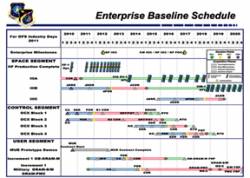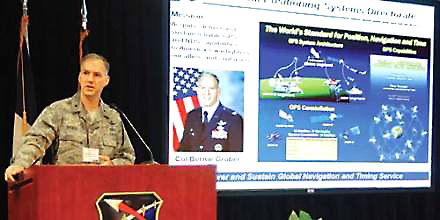 Enterprise Baseline Schedule
Enterprise Baseline ScheduleCol. Bernie Gruber, commander of the GPS Directorate since June 2010, works in a busy place.
Through its various incarnations since being established in 1974 — as Joint Program Office, Air Force Wing, and now Directorate — the GPS program at the Space and Missile Systems Center (SMC), Los Angeles Air Force Base, California, has been at the center of the action.
Col. Bernie Gruber, commander of the GPS Directorate since June 2010, works in a busy place.
Through its various incarnations since being established in 1974 — as Joint Program Office, Air Force Wing, and now Directorate — the GPS program at the Space and Missile Systems Center (SMC), Los Angeles Air Force Base, California, has been at the center of the action.
For nearly 40 years, the GPS office has served as the touchstone for acquisitions — in their current form: the modernized operational control segment (OCX), the next-generation GPS III satellites, and modernized GPS user equipment (MGUE).
The directorate’s overarching mission, the thing that its leadership wakes up to every day, is how to keep the three parallel lines of modernization initiatives on track and in synch. The GPS Enterprise Baseline Schedule chart (see inset photo, above right) — with its preliminary and critical design reviews, its key decision points, and its operational end points — reflects just how complex this endeavor is.
Gruber is no stranger to the elongated GPS acquisition timelines. He served at the wing’s predecessor organization, the NAVSTAR GPS Joint Program Office (GPS JPO) in the early 1990s, where he helped oversee user equipment acquisition, including the Selective Availability/Anti-Spoofing Module procurement that is just seeing full utility with completion of the control segment’s Architecture Evolution Plan.
Today, the directorate faces a budgetary future that is, in Gruber’s words, “flat, at best.” With the Department of Defense (DoD) overall facing its first reductions in financial resources for more than a decade, GPS could once again encounter the risk of “reprogramming” that moves funds out of its programs and into other military space projects.
But Gruber doesn’t come to the task unprepared.
In 2007, he completed a fellowship thesis at the Air University, “Streamlining the Acquisition Process: A Strategic View on Behalf of the Warfighter.” The paper explored how the DoD can have “a streamlined and flexible acquisition process in a fiscally constrained and complex security environment that directly benefits the needs of the warfighter.”
When we sat down to talk with Gruber, he had just keynoted the annual GPS Partnership Council meeting, organized by the Los Angeles chapter of AFCEA, the Armed Forces Communications Electronics Association, which was held at the SMC May 3–4.
Under the theme, “Executing Modernization . . . Enabling New Paths and Beyond,” the meeting offered some 300 industry and agency representatives and uniformed personnel the directorate’s perspective on the GPS enterprise as a whole.
Among the highlights of the event was a warfighter keynote and panel discussion, featuring military pilots and special operations personnel, who spoke in anecdotal detail about their PNT needs in the field and how their GPS equipment works — or doesn’t work so well — for them. Their witness as the ultimate customers for the GPS Directorate seemed very much on his mind during the conversation that followed.
Inside GNSS: I would like to begin by asking about the synchronizing of those acquisition programs that you and the GPS Directorate are involved with — the ground, space, and user segments. At one point I heard someone mention the need to overcome that 15-month gap between launch of the first Block IIIA and OCX-A coming on line, and then how does that fit with the modernized user equipment. Where are those three programs OCX-A, IIIA, and the MGUE effort converging?
Col. Bernie Gruber: Okay, Glen, let me take those one at a time and talk about the synchronization and the convergence first.
Last fall when we visited OSD [Office of the U.S. Secretary of Defense] they asked the very same question, and we addressed it through the Annual GPS Enterprise Review (AGER) in the December time period. Although we presented the data to them, they wanted to actually drill down a little bit deeper to understand how this related to capability timing and what does it [synchronization] mean.
So, my team from the EN [Engineering] directorate actually put together what we call capabilities synchronization schedules. What those schedules do is actually take the advanced control segment, or OCX, the GPS III space vehicle modernization program, and the Military GPS User Equipment (MGUE) program and lay them all together to show critical touch points, dependencies and initial/full operating capabilities.
This effort forced us to ensure our three segments were synchronized as much as possible while illustrating our timelines. We will continue to treat these schedules as living documents. Additionally, it was good to see the Congressional language that came in this year, that basically said all receivers built for the military produced after FY17 [Fiscal Year 2017] must have M-Code capability. That really gives you a nice end state.
Now, let me address your other questions. There has been a lot of information given about the quote/unquote “gap” between the launch of our first GPS III space vehicle [scheduled for mid-2014] and the ability of the ground to command and control it through a launch and checkout system.
We actually had identified this as a potential gap back in 2007. But let me tell you we have come a long way since then; we have just released an RFP, request for proposal, that will actually close this gap from what was a 15-month delay to actually now having a system with initial capability 12 months early in the program. It will be called the Launch and Checkout System or LCS and is bounded by an overall capability that we call the launch and checkout capability.
The LCS system will do exactly as the name implies: it will be able to command and control the first GPS III satellite, and it will be able to do all the characterization, analysis, anomaly resolution that we need to prior to turning the vehicle over to the 50th Space Wing for operations. Additionally, we’ll have reach-back through the tools and trending and system analysis reports to make sure that the vehicle is fully ready to be part of the constellation.
Inside GNSS: About how long do you do the characterization of the satellite and how long before it will actually go operational?
Gruber: That’s a good question and it comes up a lot. Bottom line up front – both the ground and the GPS III satellite will be ready for operations [or ready to operate] on the same day we turnover OCX to the 50th Space Wing, our partner [at Schriever Air Force Base, Colorado]. Spacecraft control authority turnover will happen approximately a year and a half after the launch. We will probably compress that timeline a bit in the end, but folks have to realize that full operational testing, verification, and validation can take some time with a first-article vehicle.
Inside GNSS: Back to LCS for a minute, Col. Gruber, what is the long-term plan for it and can you explain what operational testing will take place?
Gruber: Sure. The LCS applies to both the ground and space segment. The LCS capability does the launch and it does the checkout of the satellite system from our Lockheed Martin facility in Newtown, Pennsylvania. That LCS capability will be completely incorporated into the Raytheon-built OCX control segment as part of its planned architecture. That’s important for people to understand. We’re not building a separate stand-alone system that will be thrown away later when OCX Block 1 comes on line.
As I mentioned, the LCS will be built and verified well before the launch. We’ll launch the vehicle, and then take about six months to check out the GPS III satellite itself. When that is completed, the OCX control segment will go through what we call its DD250, or its official acceptance by the government. . . . then we will do all the ground checkout testing and verification that needs to happen — and of course we’ll have a live interface between the control segment and the spacecraft itself. This live testing will be part of our operational testing of all GPS satellites types, ground interfaces, and user equipment.
Now, during that time, one of the benefits for us is that we actually go through our operational tests on everything that’s already flying up there to make sure that the ground control segment works with all legacy vehicles. But, in addition to that, we’ll be able to do the full operational tests that we’re doing for GPS III and coordinated with our partners at the 50th Space Wing.
The way I look at it we’re getting added benefit of all our teams working together; and you don’t have to go through it [operational verification of the control segment] twice. And that brings me to the last piece of the operational timeline which is called an operational utility evaluation.
That’s where you have the trainers, evaluators and the 2nd SOPS [Space Operations Squadron] from the 50th Space Wing full up and running to be able to do all their commands; this way they will be able to fully prepare for takeover of the system. Our operators will start familiarization training in 2012 and, of course, we’re going to continue that training.
Inside GNSS: Okay, that takes care of the space and ground segments. Let’s talk about the MGUE program and the CGM or Common GPS Module concept. How are you going to do that? It really seems like a paradigm shift and the encounter of two cultures — consumer electronics products culture and their expectations of economies of scale and technology refresh cycles, and yet you’re still going to have standards, interface requirements, contracting. Industry’s going to need to take a risk — but when you think about the non-recurring engineering costs, I wonder how that’s going to go down with them.
Gruber: Let me talk about the military side of MGUE first. As you know from this week at the Partnership Council, we have had three ongoing contracts with Raytheon, L3, and Rockwell Collins. Every one of those vendors has delivered their ground-embedded receiver cards, which are currently in testing down at SPAWAR [Space and Naval Warfare Systems Command] in San Diego.
We’re learning a lot about the products, and the testing is actually going very well. Our intent is to be able to give those suppliers feedback on the performance of their receivers right now; critical tests like cryptography, anti-spoofing, anti-tamper, anti-jam properties and time-to-first-fix. Most importantly, every one of the receivers is processing M-Code. We’re very encouraged by the results we’ve seen so far.
The next phase [in the MGUE program] is to prepare our RFP with the first step being a pre-RFP, which is really a request for information. We are now structuring selection factors and preparing the document for government approval. The final will go to industry this fall. So, we’ll actively get feedback from the testing that’s ongoing and incorporate that into the RFP. My goal, quite honestly, is to be able to make this environment competitive and to be able to offer an opportunity for vendors and suppliers for unique applications of which they see fit.
Inside GNSS: And how will you do that?
Gruber: Through the balance that I talked about during the first day of the partnership council: on one side we have to make sure, just as you said, that the interface control documents [ICDs] and specifications are rock solid. We have to make sure that our IA — information assurance — boundary is clean and secure, and then we need to go through a security accreditation.
Now, let’s put this together with the incredible explosion in GPS use. As you know, there are many, many suppliers worldwide right now that are developing incredible and different types of applications that employ GPS. So, how can we in government take advantage of that by still meeting the ICD requirements and security requirements?
I believe you can look at this in one of two ways: you can try and build a single receiver that does everything for everyone, or you can build a very small protected core that every military receiver must use. We then allow that protected core, which contains the military GPS crypto-engine, to be able to interface with anything they want.
And I personally don’t ever want to preclude that from happening, because then you stymie innovation and you stymie creativity if you do. We’ve been asked to build form factors for lead platforms for air, maritime, and ground domains, and we’re going to continue to do that under the programs that you asked about before, the GRAM-SM and others. But as I see it, this can open up the doors to many different users and open a dialogue with the 53 international partners we have right now.
Inside GNSS: But there’s still the question that the consumer market works a different way. The decision making is individual. The individual consumers looks at the various options they have and looks at the feature set, looks at the pricing, makes a value decision, and chooses that.
You open that up to tens of millions of consumers, and that’s your market. Even if the [military] acquisition authority becomes more distributed among the various warfighting commands or whatever, those are the ones that begin specifying and purchasing the equipment, the apps that they need, rather than going through the directorate.
Gruber: You’re absolutely right; they [warfighting commands] could be allowed to do that. Again, as long as the interface compliance is still there on the IA boundary, the ICDs and security.
Inside GNSS: But then you no longer have the tens of millions of individual decision-makers who you can market to, and reach and shape products for, and have refresh cycles that they understand. You have a much more limited set of decision makers, people who are making decisions on behalf of large numbers of users. So, how will that cultural boundary will be crossed?
Gruber: Right, it’s a balance, isn’t it? I loved the comment from one of our warfighters this week when he said “why can’t we have a GSA app store” to allow individuals to download what they need and want. There is nothing we want to do in the GPS directorate to preclude an opportunity like this — but it will take some work, especially on the contracting and logistics side.
Inside GNSS: What kind of vendor feedback are you getting about the CGM? And it’s no longer just Raytheon and Rockwell and Interstate. It’s u-blox, GARMIN, or Magellan, or whoever else?
Gruber: [They are saying] just exactly that: We want to be able to play and we’re excited about products that we will be able to give to the government. And we [the GPS Directorate] think that we have heard from our customer base out there that there’s a genuine need for what other vendors have to offer. That just puts a smile on my face, because that’s exactly what I want to hear — I truly believe this time of competition will reduce costs and propel ingenuity.
Inside GNSS: What are their questions about how that’s going to be done?
Gruber: The questions are directly in line with what we said. “Allow us to give you feedback,” and we’re trying to do that through the pre-RFP process, “Try not to stymie us,” “Don’t lock up the market with one vendor. . . .”
Inside GNSS: So, you have the RFP later this year. Is that just for the three vendors you have under contract now?
Gruber: It will be a full and open competition. . . . You’re familiar with how SAASM [Selective Availability/Anti-Spoofing Module] chipset has been used, right? So, kind of think about it in the same category. Just as SAASM is built by different vendors today, there are multiple vendors that are not actually contracting through the GPS program directorate that have delivered equipment to the field, whether those be housed in missiles, rockets, or other types of handheld equipment.
We’ve spent a lot of time speaking about those three variants [air, ground, maritime] because that’s what we’ve been asked to produce by our services — meaning the Army, the Navy, the Marine Corps, and the U.S. Air Force.
Inside GNSS: But when we talk about the high-volume, consumer type of product and business models, we’re really talking about the handheld devices?
Gruber: There’s going to be high-end GPS receivers that will be out there, and that will have a niche market unto itself, and people can play within that. Your question specifically is about high-volume, and what I envision as a high-volume market is certainly the handheld equipment, but I also envision extremely high volume from munitions, radios, and Remotely Piloted Vehicles in the future.
Inside GNSS: Maybe from the vendors’ point of view, from the manufacturers’ point of view, is they are already developing their equipment and the capabilities and whatever, and the new thing, all they have to do, really, is basically get the security clearance, accreditation, to be able to interface with that CGM?
Gruber: Correct.
Inside GNSS: . . . and just be able to put it on board some platform that they have already developed, maybe adding some bells and whistles based on particular needs of DoD users.
Gruber: Right. That’s why we say, if people want to able to develop a GPS/INS for a specific user, great. If people want to develop a GPS/comm type system like a JTRS [Joint Tactical Radio System] type platform or something like that, great. Again, we don’t want to do anything to preclude that from happening in the future. Just like we’ve seen the commercial world take off, with the same type of embedded things [going] into cellular telephones and different types of data distribution devices. . . .
It will come in phases and over time. You know, GPS has such an incredibly wide user base that it takes time to be able to incorporate everything out in the field. Recall, the Joint Chiefs selected SAASM back in 1998 and then mandated it in every receiver post-2006. So, it will be multiple years before we fully populate the field with CGMs.
The successful prototyping program under the Modernized User Equipment (MUE) program could yield early products if users seek out the MUE vendors directly. We intend to support that effort by conducting security evaluations and certification activities.
Inside GNSS: That’s assuming that [the FY17 requirement] is not an unfunded mandate from Congress.
Gruber: Well, we’ll have to see. Congress, of course, appropriates for single years, and we budget fully across five years. What we have to do is make sure that we, and our users, continue to put those requests to Congress. . . .
Inside GNSS: Let me ask you about the role of the directorate in international cooperation. You mentioned both the 2004 NSPD [National Security Policy Directive on Space-Based Positioning, Navigation, and Timing] and the new National Space Policy announced last year, which said “foreign positioning, navigation, and timing (PNT) services may be used to augment and strengthen the resiliency of GPS.” Do you understand the phrasing “to strengthen resiliency” of GPS using foreign systems to also be addressed to the military?
Gruber: I do. But people will interpret it in different implementation architectures. So, resilience really can come in . . . many, many different [forms]. Resilience can come through numbers and redundancy. Resilience can come through hardening requirements based on protection of space environments or protection of datalinks. Resilience can come in the fact of having terrestrial solutions and spaceborne solutions. . . . As I mentioned in my talk to the Partnership Council, it all goes back to balance and best value. What is the best way balance those based on the funding we have available to us right now and the critical needs of the warfighter.
Inside GNSS: Do you have final thoughts that you want to add?
Gruber: Just that I always like to give a special thank you to the hard-working people at the GPS Directorate, I couldn’t be prouder of the team we have. They have this amazing ability to take on huge issues while keeping this worldwide utility alive and well, and with our partners at the 50th Space Wing to be able to ensure we are the gold standard for global navigation far in to the future. Thanks for supporting GNSS, Glen, and this wonderful utility called GPS!





